Wolfssymbolik und Bedeutung
 What is the Symbolism & Meaning Behind the Wolf?
What is the Symbolism & Meaning Behind the Wolf?
Many people are fearful of wolves and think of them as vicious, aggressive creatures, but these feelings are mostly a result of cultural conditioning, as the truth is far different. While it is true that wolves are predators, they are actually quite friendly, sociable, family-oriented, and tend to stay away from humans (this is most probably because humans have once hunted them to near-extinction).
Wolves are known to depend on each other to survive, to place the interests of the wolf pack and their family before their own, and can be ferocious if a loved one is in harm's way. They are also known to pass on knowledge from one generation to the next and are said to have sacred territories.
They are a symbol of wildness, a deep connection to one's instincts, intelligence, the appetite for freedom, family, loyalty, protection, and playfulness.
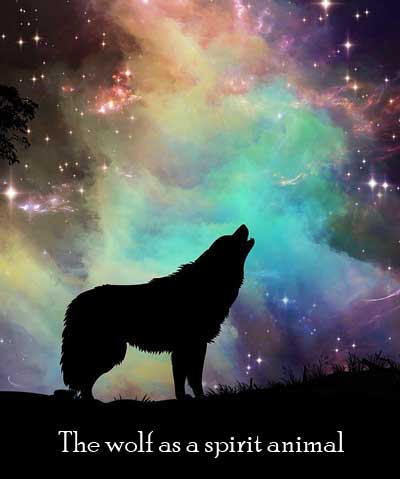 The Wolf as a Spirit Animal
The Wolf as a Spirit Animal
It is said that a wolf may be your spirit animal if you had experiences with wolves in the past where you felt a strong connection to them. It isn't necessary that you had an encounter with a real wolf; it may just be that you watched a movie or read a book about wolves and it had a powerful effect on you. Or, it could be that you were fascinated with them as a child or have had recurring dreams about them.
If the wolf is your spirit animal, it may mean that you have a wolf-like predisposition, in that you are strongly guided by your instincts and feel a need for freedom, while maintaining a sense of duty towards your community and family.
If a wolf spirit guide shows up during a dream or meditation, it may be a call for you to live life more freely, more powerfully, and to do things you are passionate about in your day to day life. It may be an invitation to embrace your true spirit.
However, depending on how the wolf shows up, it may also have a negative meaning. A wolf can represent a threat or be a reminder of a person or situation that makes you feel threatened. It may be a call to reevaluate your relationships and to strengthen your emotional or physical boundaries.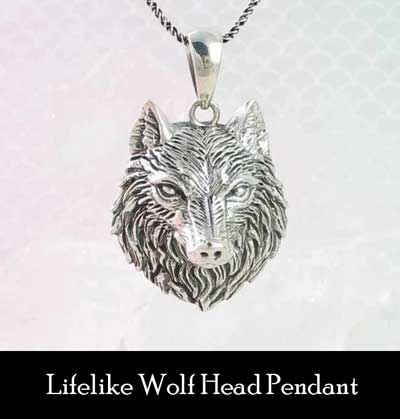
It may be telling you to trust your instincts when there seems to be someone or something in your life that seems "off". Perhaps it is a new job or relationship you are in; your wolf spirit guide may be warning you to pay attention to your instincts, even if everything seems okay on the surface.
It may also be a signal to take note of how you feel in your environment. Wolves are perfectly suited to their environment and move through it with a combination of strength, grace, and stamina. They can run at a speed of 35 mph while chasing prey or jog at a relaxed pace for hours.
Likewise, humans are meant to move throughout the day. How does your environment make your body feel? Is there a way you can change it so that it is more in tune with your body? Sometimes, even a small change like deciding you will take the stairs instead of the elevator or go for a walk during your lunch hour can make a big difference.
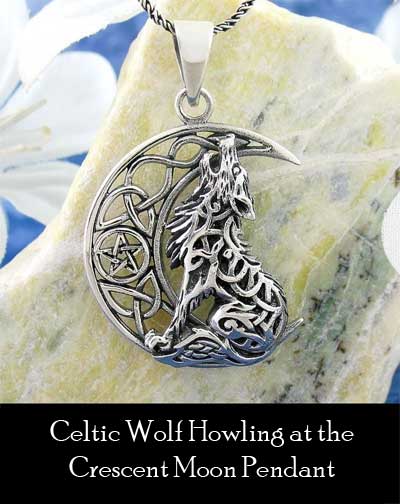
Celtic Wolf Symbolism
Wolves were sacred animals to the Celts and seen as powerful helpers, guides, and symbols of transformation. It's surprising then that today, wolves no longer exist in Ireland, even though they were once widespread. In the Middle Ages, the Irish government promoted their extermination, mostly because they were a threat to livestock and business. Large bounties were paid for wolves that were killed and by 1786, it is thought that the last wild wolf was killed in Ireland.
There are many wolf stories in Celtic mythology and even Celtic tribes that claim to be descended from wolves. The Celtic hero, Cormac mac Airt is said to have been raised by wolves and knew how to speak their language.
There are also stories of shape-shifting wolves that can change from human to wolf or to something in between, a werewolf. The werewolves of Ossory were said to be descendants of a legendary figure named Laignech Fáelad who was half man/half wolf. The stories of these werewolves may have been linked to the "fianna", bands of young warriors who mostly lived in the woods and had a wild, dishevelled, or naked appearance. They wore wolf skins and styled their hair to look like wolves when went "wolfing", on raids to attack both humans and animals.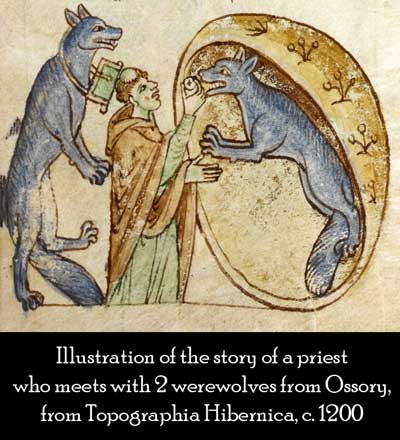
Another notable myth related to the werewolves of Ossory tells of a priest travelling from Ulster to Meath who meets a talking wolf. The wolf said he was from a place called Ossory and that a curse had been placed upon his people whereby every 7 years, a man and a woman were turned into wolves. After 7 years, they became human again and another 2 people turned into wolves, suffering the same fate in an endless cycle. He and his wife were currently living though this wolf phase, but his wife was dying. He asked the priest to give her the last rites. The priest did it and the grateful wolf showed him the right road to Meath.
The Morrigan, the beautiful Celtic goddess of war and death, is said to have transformed into a red she-wolf in a battle with Cuchulainn.
In Scotland (which is considered one of the six Celtic nations), there is the story of the Wulver, a friendly werewolf who lived in a cave and could often be seen sitting on a rock and fishing. He would sometimes leave a fish as a gift on someone's window sill.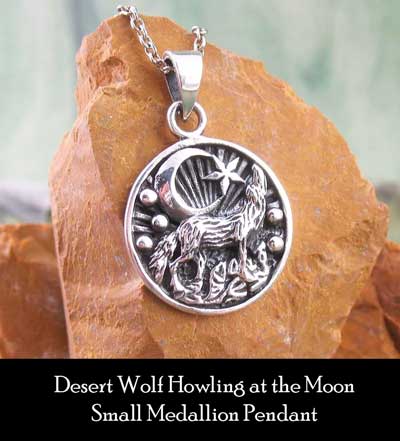
In Irish mythology, the daughters of Airitech were three werewolf-like creatures that would come out of the Cave of Cruachan every year and kill sheep. The hero Cas Corach knew they liked music, so he used a harp to lure them out and persuaded them to change into their human form, after which all three were killed with one spear.
The wolf is a companion to Cerridwen, the goddess of the moon and fertility, and Cernunnos, the horned woodland god of fertility and hunting. One of the most famous depictions of Cernunnos is on the Gundestrup Cauldron, an ancient vessel dating from between 200 BC to 300 AD, where he is accompanied by wolves.
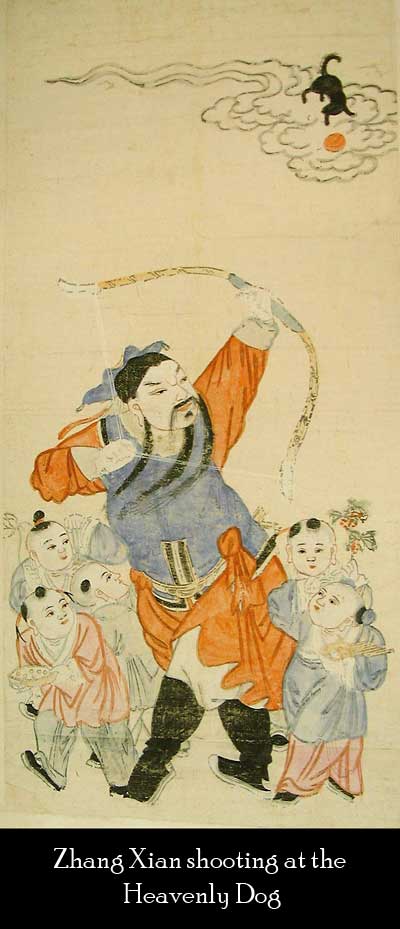 Wolves in Chinese Culture
Wolves in Chinese Culture
In China, lunar eclipses happened because there was a bad spirit named the Heavenly Dog that ate the moon. It is also called the Celestial Wolf, Heavenly Wolf, or Sky Wolf, and was associated with the star Sirius, which interestingly, is known as the Dog Star in many cultures.
Chinese people used to make noise by beating on pots and pans, drums, and gongs, and setting off firecrackers to scare the Heavenly Dog away.
There is an interesting Chinese idiom, "heart of wolf and lungs of dog", which means a cold-blooded, ungrateful, heartless person who lacks empathy. It comes from the legend of a folk doctor named Bian Que who was on his way up a mountain to treat his patients when he came across a man lying on the ground. The man first appeared to be dead, but then Bian Que realized that he was breathing slightly. The doctor determined that he just needed a new heart and lungs to live again.
As he was trying to decide what to do, a wolf passed by. He killed the wolf and put its heart into the man. Then, a dog passed by and the doctor killed the dog and put its lungs into the man and he suddenly came back to life. But instead of thanking the doctor, the man accused him of stealing his money. No matter how much the doctor tried to explain what had happened and even after showing him the scars on his chest from the surgery, the man continued to accuse the doctor of stealing his money. And to this day, the idiom "heart of wolf and lungs of dog" is used to describe such a person.
Wolf Symbolism in Japan
Wolves play a prominent role in Japanese beliefs. The Ainu, indigenous people who inhabit Hokkaido, the northernmost island of Japan, believe they are the descendants of a white wolf who mated with a goddess. In old Ainu times, before the people were persecuted and driven off their native lands by the Japanese from the south, wolves were numerous in the landscape and in magical times, helped people and came down from the heavens to live in sacred mountains and forests. 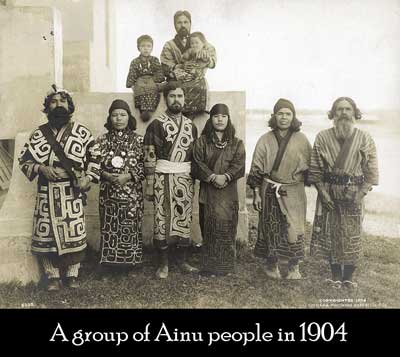
Aside from the Ainu people, wolves can be found in many Shinto shrines throughout Japan. Shinto is Japan's indigenous religion, a nature religion that worships spirits believed to inhabit all things. The wolf can often be found in Shinto shrines, either as a divine messenger or as a god himself.
The wolf deity, Ooguchi-no-Magami (meaning deity with a great mouth) has a festival held in honor of him each January.
As in other cultures, the Japanese have stories of wolves as guides and helpers. An ancient myth tells of a white wolf that came to the aid of an emperor's son when he came across a demon that had shape-shifted into a deer and was blocking the path. The white wolf showed him a way around and led his army on the path to safety.
Another story tells of an old wolf in the Nara region who killed and ate many humans. To appease him, he was given deer and wild boar. He came to tell the difference between the humans that fed him and the wild animals, and became a protector of good people, while punishing bad ones.
Sadly, today wolves are extinct in Japan. In the 1700s, Western influence, the threat of wolves to livestock, and then the spread of rabies to the wild wolf population, caused them to be hunted to extinction. The last wild wolf was thought to be killed in 1905.
Wolf Symbolism in Egypt
In ancient Egypt, Wepwawet was originally a war god whose name meant "opener of the ways". Some say he is a sort of scout, looking for the safest and clearest routes for the army to proceed.
Because of his associations with war and death, he eventually became the one who opened the way to the afterlife, leading the dead to their final judgement by Anubis, the god of the dead.
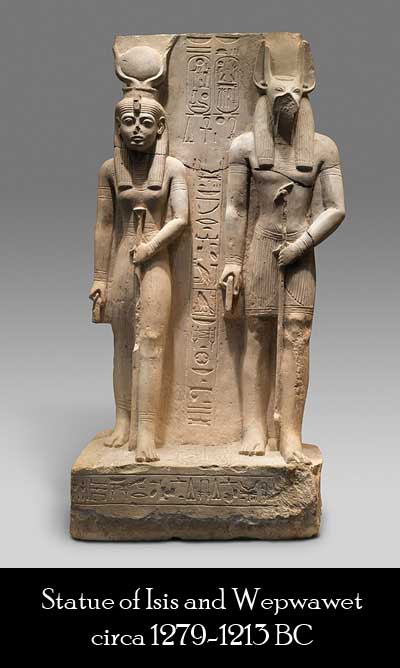
Wepwawet is often shown with gray or white fur, sometimes as a man with a wolf head, or sometimes just as a jackal or wolf. He can be found standing on the prow of a solar boat, a funerary vessel or barge thought to be used to carry the pharaoh to the afterlife.
He also assists in the Egyptian death ceremony known as the "Opening of the Mouth", a ritual involving spells, the sacrifice of a calf, and various tools, allowing for the deceased to be reborn again as an "akh", the Egyptian idea of a soul. The ceremony would allow the deceased person to see, speak, hear, breath, and receive food and drink in the afterlife.
Wepwawet is sometimes confused with Anubis, the god of the dead, because of their similar appearance. Some say that Anubis was not actually a jackal, but a wolf as well, because DNA has shown the African jackal to be a sub-species of the gray wolf.
The ancient Greek historian Herodotus noted that Egyptians had great respect for wolves, because wherever they were found lying, they were buried.
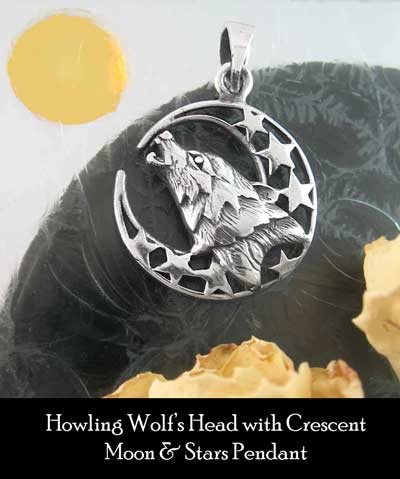
Native American Wolf Symbolism
The wolf was a highly respected and sacred animal to many tribes in North America. Their stories are much too diverse to go into any kind of detail here, but there are some common themes:
- Symbolism: They are generally associated with courage, strength, loyalty, teamwork, and success in hunting.
- Hunting: Native Americans respected the hunting skills of the wolves and tried to emulate the way wolves hunted in teams and how each individual worked for the common good of the whole. Apache warriors would pray, sing, and dance to gain the teamwork, strength, and bravery of wolves. Cheyenne warriors would rub their arrows against wolf fur for more successful hunting.
- Related to humans: They were seen as being closely related to humans because of their family-like qualities and the hierarchy of the wolf pack, and were often referred to as a brother or sister. The Ojibwe felt that anything that happened to wolves would eventually happen to their tribe.
- Humans as descendants: Many tribes credit the wolf with the creation of Earth or believe that humans are the descendants of wolves, so wolves were worshipped as a god and ancestor. The Cree tribe thought that wolves came down to Earth when the Northern Lights shined. The Quileute and Kwakiutl tribes believe humans are descended from wolves.
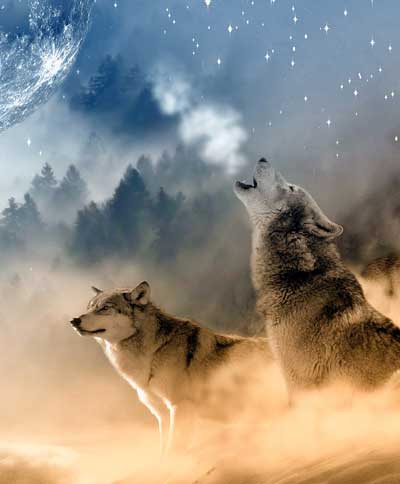
- Divine spirits: They were considered divine creatures. The Sioux called them the "animal that looks like a dog, but is a powerful spirit". The Hopi would dress as wolf kachinas (spirits). Some tribes believed that wolves howling at the moon were spiritual beings speaking to the god and had magical powers. In Lakota, the word for wolf means "divine dog". Pawnee and Blackfoot tribes view the appearance and disappearance of the star Sirius (also called the "Wolf Star" or "Dog Star") as a sign that wolves were travelling to and from the spirit world.
- Helpers and guides: Wolves were thought to have healing qualities and the Navajo call upon them to heal the sick. An Omaha legend tells of a wolf who guided a wounded warrior back to camp, helping him to avoid dangers along the way. They were also known to give guidance in dreams and meditation.
Wolves and the moon in Pawnee folklore
The full moon in January is called the Wolf Moon. It is believed that the name comes from the howling of wolves during the cold winter month of January. This moon is also called the Great Spirit Moon, Old Moon, Moon After Yule, Snow Moon, and Cold Moon.
The Pawnee Indians were one of the most respected tribes in North America. Their name means "wolf", and so they are the tribe of the wolf. In Pawnee folklore, the Great Spirit, Tirawa, placed the Wolf Spirit in the sky as the guardian of the moon. Three other animal spirits, Black Bear, Mountain Lion, and Wild Cat were sent to be alongside him. These star animals sent likenesses of themselves to live on earth and were responsible for many of earth's weather phenomena and natural wonders.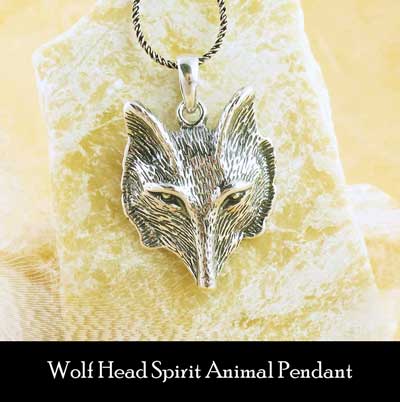
Although the star animals were powerful, the Morning Star, the Sun, was still greater and it sent the star animals to hold up the 4 quarters of the universe.
Wolf Spirit is now the devoted spirit of the Sun, but his likeness on earth can still be heard howling at the moon. It is thought that the wolves on earth howl because they remember their ancient ties to the moon.
Hopi Kachina Dolls
Kachina dolls are figures carved by the Hopi people to teach their young women about spirits that bring rain, control the natural world, society, and are messengers between people and the spirit world.
The Wolf Kachina is often seen alongside the Deer or Antelope Kachinas. The stick he holds in his hand is said to symbolize the trees and bushes he hides behind as he hunts them.
Wolf Dreamcatcher Symbol
To better understand the wolf dreamcatcher symbol, we need to understand the two symbols separately. The dreamcatcher comes from the Ojibwe people who currently live in the areas of Canada and the United States north of the Great Lakes region.
The Ojibwe believed there was a spirit called the Spider Woman who watched over them. When the people spread to the four corners of the world, she had trouble reaching everyone, so she taught the people how to wear webs inside of willow hoops, using thin pieces of sinew from the animals they hunted. The people saw these hoops as a filter for bad energy, allowing only good energy to pass through to them as they slept.
The shape of the dreamcatcher is a circle, which represents many important things to Native American people - the medicine wheel, the bottom of a tipi, the circle of life, the seasons, and the sun, moon, and earth. The small circle at the center is where the good dreams pass through.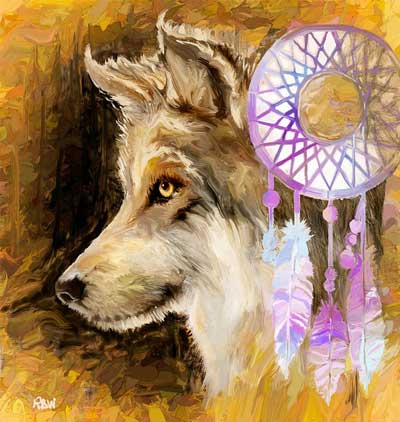
In Ojibwe, the word wolf is Ma'iingan, which means "The one put here by that All Loving Spirit to show us the way". The Ojibwe considered the wolf to be part of the family and were often referred to as a brother or sister. Wolves were thought to be the wisest of all animals and taught people the proper way to live and hunt.
The symbol of the wolf dreamcatcher combines the energies of the two symbols for a powerful effect. The dreamcatcher, whose protective properties come from the Spider Woman spirit, protects you from bad energies, while allowing good energies to come through. The wolf, along with its powers of wildness, instinct, intelligence, and ferocity, also reminds you that nothing should be done selfishly, but should be done for the greater good of the tribe, clan, or community.
Wolves in Norse/Viking Mythology
Fenrir
Fenrir is the most famous wolf in Norse mythology, but also its most notorious villain. Fenrir ends up causing great destruction and the death of Odin, the All-Father, but when you read his story, you might understand why he did what he did.
The story begins when the frost giantess Angrboda tricked Loki into having children with her. The three children were Fenrir the wolf, Jormungand the snake, and Hel, a girl born half-dead. The Aesir, the gods of the Norse pantheon, soon discovered these strange children and heard a prophecy that they would destroy the gods during Ragnarok, the end of the world.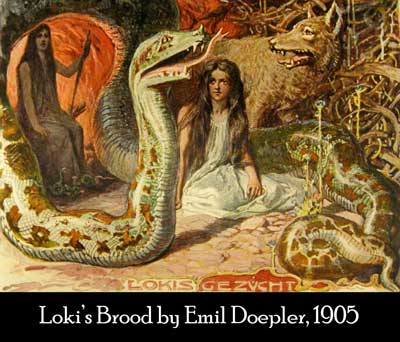
The gods decided to put these children in the places where they might cause the least harm. The children were stolen in the middle of the night. Jormungand, the snake, was thrown into the oceans where he would eventually grow so large that he would encircle the earth and end up biting his own tail. Hel, the half-dead girl, was sent to Helheim, the land of ice and frost, where she ruled over the dead. As for Fenrir, the gods decided to keep him and raise him up themselves.
Tyr, the god of law and honor, was the only one brave enough to feed Fenrir everyday. Time passed and the gods were astonished at how quickly he was growing. They soon decided that they could not keep him forever, but they also felt that if they set him free, he would cause great destruction throughout the land.
So they came up with a secret plan to trap him. They asked their blacksmiths to create a binding, which they presented to Fenrir as a fun game to test his strength. They said that he could put on the binding and that if he broke it, he would become famous. Fenrir eyed the binding and decided that, although it looked strong, he felt he was stronger still and agreed to be bound. With one heave, Fenrir easily broke free.
Alarmed, the gods asked their blacksmiths to make an even stronger binding. Fenrir was a bit more wary of this much heavier-looking binding, but decided that the possibility of becoming famous was worth the risk. Again, he allowed himself to be bound. This time, it took him two heaves to break free and he roared with satisfaction, for he was indeed stronger than even this chain.
Now truly distressed, the gods knew they could not make a chain strong enough to restrain the wolf. So Odin, the All-Father, sent one of the gods to the land of the dwarves. He asked the dwarves to make a chain that was impossible to break.
To achieve the impossible, this chain, Gleipnir, was made out of six impossible things - the sound of a cat's footsteps, the beard of a woman, the roots of a mountain, the breath of a fish, and the spittle of a bird. Gleipnir was smooth and soft as a silken ribbon, yet stronger than any iron chain. When Fenrir saw this new binding, he immediately became suspicious and refused to be bound.
Each of the gods taunted him, saying that since he broke those heavy chains, this flimsy ribbon should be no challenge at all. Still suspicious, Fenrir made a deal. He said that if one of them was willing to put their hand in his mouth, he would allow himself to be bound. Fenrir felt that if there was no trickery involved, then the gods should have no problem putting their hand in his mouth because if he was able to break free, no harm would come to anyone.
Hearing this proposition, silence fell, and none of the gods stepped forward, for all of them knew this was a dirty trick on their part and none of them wanted to lose their sword-hand. Finally, Tyr came forward, deciding that it would be worth the possibility of restraining Fenrir. So Fenrir allowed himself to be bound and quickly found that no matter how he thrashed and heaved, he could not break the binding. In his anger, he ripped Tyr's hand from his arm. All the gods were laughing except for Tyr, now missing his hand. The more Fenrir struggled, the tighter and stronger the binding became. Fenrir howled in distress and lunged at the group of gods, to no avail.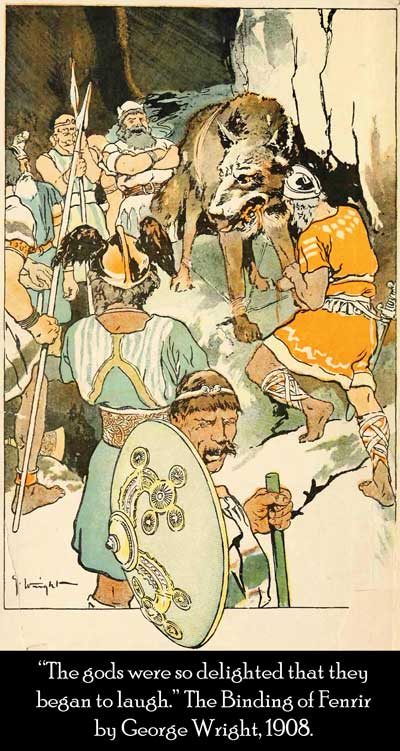
They then took an unbreakable chain, the Gelgja, attached it to the binding and dragged the wolf to a desolate island, where they attached him to a boulder and proceeded to pound it into the ground, putting another rock on top to fasten it.
Fenrir continued to howl and lunge at the gods, so one of them shoved his sword into the wolf's mouth, with the hilt on the lower jaw and the tip on the upper jaw, holding open his mouth so that he was effectively gagged. Foamy saliva ran from Fenrir's mouth and formed the river Ván, which means "Expectation".
When Ragnarok started, Fenrir broke free of the binding. With flames burning from his eyes and nostrils, he opened his mouth so wide that his upper jaw touched the top of the sky and the bottom was on the earth, and devoured everything in his path. He would eventually kill and eat Odin for his betrayal, a testament to his extraordinary strength. Fenrir was later killed by Viðarr, Odin's son.
Thus the gods, instead of teaching Fenrir to be all that he could be, instead turned him into the very thing they feared most.
Fenrir is a symbol of wild strength, independence, loyalty, family, and a burning desire to free one's self.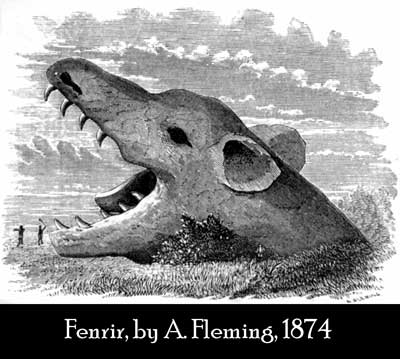
Other wolves in Norse mythology
Two wolves, Geri and Freki, were said to accompany the god Odin. Their names meant "the ravenous" or "greedy one" and were said to be "greedy for the corpses of those who have fallen in battle". Odin always gave all of his food to these two wolves, taking none for himself, as for him, wine was both meat and drink.
Hati and Skoll, the "the one who hates" and "the one who mocks", were two wolves that would chase after the sun and moon everyday. It was not until Ragnarok that they finally caught up to their prey, devouring them and causing total darkness, wiping out any sense of time.
Negative Symbolism of the Wolf
In some parts of the world, the wolf is feared, especially in places where agriculture is the main source of sustenance, as opposed to hunting and gathering. Wolves have been accused of attacking livestock and humans, even though they prefer wild prey and normally try to avoid humans. It was this threat to livestock and the influences of Christianity that led to wolves nearly becoming extinct in Europe.
Wolf Symbolism in the Bible and Christianity
In the Book of Genesis, the wolf is repeatedly mentioned as an enemy of the flocks. This was a metaphor for dishonest, greedy men who wanted to take advantage of innocent people and also a metaphor for Satan preying on God-fearing Christians - the Devil's servants, as opposed to Jesus, who was a shepherd that kept his flocks safe.
The Roman Catholic Church used these fearful ideas to give the impression that wolves were real devils wandering in the real world. The Malleus Malleficarum, one of the best known works against witchcraft, quoting from Leviticus and Deuteronomy, says that wolves are either agents of God sent to punish sinners, or agents of the Devil sent to harass true believers to test their faith.
In the New Testament, Jesus compared wolves to dangerous and treacherous people, thus legitimizing their persecution. In Matthew 7:15, a verse in the Gospel of Matthew, it reads, "Watch out for false prophets. They come to you in sheep's clothing, but inwardly they are ferocious wolves." Wolves eventually became a symbol of evil - a threat to Christ's flock and became hunted extensively.
But even worse than wolves were werewolves, a half man/half wolf creature that had the intelligence of a man with the viciousness of a wolf. People who were thought to be able to shapeshift into wolves were hunted alongside witches in the infamous witch hunts.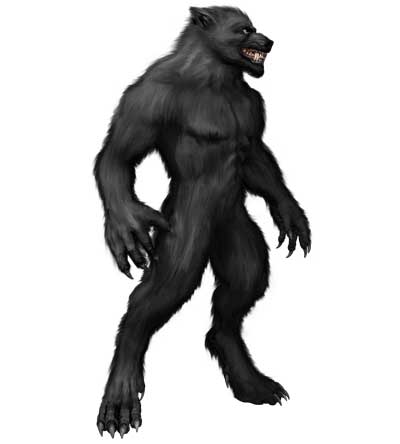
When the Europeans arrived in North America in the 16- and 1700s, they brought these fears with them. They felt that they were in a wild land that needed to be tamed. What they didn't know, they feared, and the Church only stoked these fears, creating a dark cloud in people's anxious imaginations. The wolf, already a symbol of evil, became a symbol of the wilderness, the unknown, a place to be feared and that needed to be tamed. These fears led to the slaughter of hundreds of thousands of wolves.
These negative images of the wolf are also evident in European children's tales, such as Little Red Riding Hood and The Three Little Pigs.
There is at least one positive representation in the Bible about a wolf which was attacking the people and livestock of the town of Gubbio. The wolf roamed the areas just outside of the town and when people tried to kill it, they would get eaten. It got to the point where no one would venture outside the town walls for any reason.
St. Francis, who lived in the city, decided he would go talk to the wolf. When he first encountered the wolf, it lunged at him, but he then made the sign of the cross and commanded the wolf to stop, in the name of God. It was then that the wolf came and lay docilely at his feet.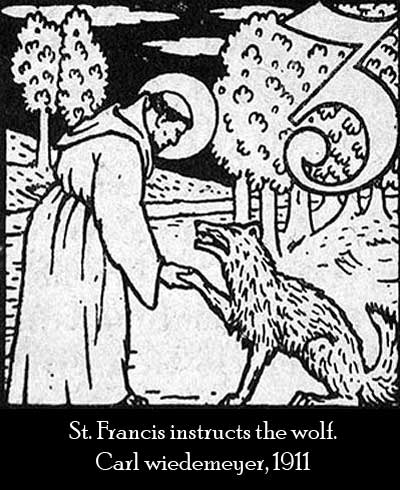
St. Francis, finding that the wolf only attacked the town because he was hungry, made a pact with the wolf, asking it to stop attacking people if they were willing to feed him. The wolf agreed and came back to town with him.
And so it was that St. Francis had created peace by encouraging the people to show kindness, charity, and mercy to their greatest foe, a wolf who only attacked them because he was needy.
Wolves in Dreams
Wolves in dreams may be scary and threatening, protective and wise, or wild and mysterious. They may represent some untamed aspect of your psyche, perhaps calling you to explore hidden parts of yourself that can lead you to be more authentic. You may be afraid of this wild aspect of yourself, but acknowledging these untamed feelings can be exciting and freeing. 
Scary or threatening wolves in dreams could be a reminder of someone in your life that is invading your personal boundaries and may be a symbol for you to pay more attention to your instincts, to reevaluate certain relationships in your life and to be careful of who you trust.
It's important to remember that animals in dreams are very much related to the culture you were brought up in and to consider what the animal may personally mean to you. In general, wolves in dreams call for us to face our fears, to protect the things that matter to us, and to live more powerfully and authentically.
Etymology of Wolf
The word wolf comes from the Old English "wulf" with a Germanic origin and from the Latin word "lupus" and the Greek word "lukos".
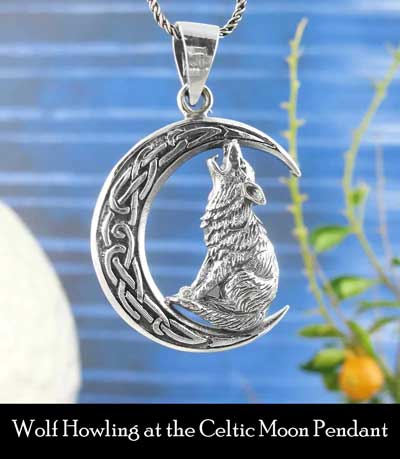
Other Intriguing Facts about Wolves
There are a number of interesting phrases involving wolves:
- To "cry wolf" means to keep calling for help when it's not really needed, to the point where when you actually do need help, no one will come.
- To "throw someone to the wolves" means to leave someone to be roughly treated by others, without trying to help or defend them.
- "A wolf in sheep's clothing" means someone who appears to be friendly or harmless, but actually has ulterior motives or malicious intentions.
- To "keep the wolf from the door" means to have enough money or resources to keep from starving or going hungry.
- To "hold a wolf by the ears" means to be in a precarious position or situation.
Wolf Lichen
There is a fungus called the "wolf lichen" that had been used for poisoning foxes and wolves for hundreds of years. The lichen contains a yellow dye called vulpinic acid, which is poisonous to all meat eaters. To poison wolves, people would mix the powdered lichen with fat and insert it into reindeer carcasses along with powdered glass.
The powdered lichen alone would have been enough to kill the wolves, but it was thought that the powdered glass, with its microscopic sharp edges, would make the animals' internal organs more susceptible to the poison.
The Wolf's Lair
Hitler built an elaborate fortress deep in the woods of Poland which he called "Wolf's Lair" (Wolfsschanze). "Wolf" was what Hitler called himself and how he was addressed by those in his inner circle. The fortress was far from major roads and urban areas. It had 3 concentric security zones and 2,000 people lived and worked there at its peak, including 20 women, some of whom were required to eat his food to see if it was poisonous.
Conclusion
I hope you enjoyed this journey with me through the meanings and symbolism of wolves around the world. There is hardly any other animal that inspires humans as much as wolves do, and it is likely because wolves seem to mirror so many of our human relationships and emotions, especially in the ways that they work and relate to each other on a societal level, yet also yearn for individual freedom and independence. I hope this article inspires you to think about how the wolf can be a guide for your life; how do the lessons of the wolf apply to you personally? Let me know in the comments!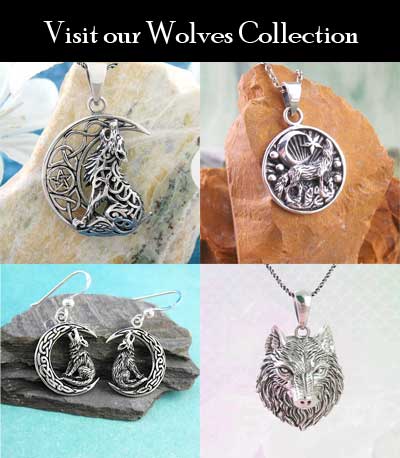
This article is brought to you by Woot & Hammy - "Our mission is to be a place for Wiccans, Pagans, and others to find affordable, high-quality jewelry that will help them express themselves and their beliefs, and by doing so, help to expand awareness and acceptance of them and their communities." Click here to visit our site.
References:
Pure Spirit, Wolf Symbolism, accessed 8/25/20, <http://www.pure-spirit.com/more-animal-symbolism/320-wolf-symbolism>
Harris, Elena, Wolf Spirit Animal, accessed 8/20/20, <https://www.spiritanimal.info/wolf-spirit-animal/>
Stanton, Kristen 2019, Wolf Symbolism and Meaning: Spirit Animal Guide, <https://www.uniguide.com/wolf-meaning-symbolism-spirit-animal-guide/>
Raph Häussler (2016) Wolf & Mythology, retrieved from https://ralphhaussler.weebly.com/wolf-mythology-italy-greek-celtic-norse.html
Raph Häussler (2016) Wolf & Mythology: Celtic, retrieved from https://ralphhaussler.weebly.com/wolf-mythology-celtic.html
Raph Häussler (2016) Wolf & Mythology: Wolf-Gods in Egypt, retrieved from https://ralphhaussler.weebly.com/wolf-mythologie-egypt.html
Immortal Mountain, Chinese Bestiary, accessed 8/31/20, <https://immortalmountain.wordpress.com/glossary/chinese-bestiary/>,
George, John Jack 2019, Norse Mythology: The Fenris-Wolf, accessed 8/27/20,<https://owlcation.com/humanities/Norse-Mythology-The-Fenris-Wolf>
Pow Wow Times 2020, Top Dreamcatcher Tattoos with Wolf and its Meaning, accessed 8/28/20, <https://powwowtimes.ca/top-dream-catcher-tattoos-with-wolf-and-meaning/>
Wikipedia, Wolves in folklore, religion and mythology, accessed 8/30/20, <https://en.wikipedia.org/wiki/Wolves_in_folklore,_religion_and_mythology>
Wikipedia, Letharia vulpina, accessed 9/1/20, <https://en.wikipedia.org/wiki/Letharia_vulpina>
Wikipedia, Wolf's Lair, accessed 9/2/20, <https://en.wikipedia.org/wiki/Wolf%27s_Lair>
Sweet Mystics, 2000-04, The Symbolic Wolf, accessed 9/1/20 http://www.angelfire.com/nv/tmyst/facts/symbolic.htm
Ford, Samantha 2018, Wolves in Norse Mythology, accessed 8/23/20, <https://wolvestuff.com/blogs/wolvestuff-blog/wolves-in-norse-mythology-wolves-in-norse-mythology>
History of Vikings 2018, Viking Wolf Symbol, accessed 8/31/20, <http://historyofvikings.com/viking-wolf-symbol/>
Wikipedia, Fenrir, accessed 9/1/20, <https://en.wikipedia.org/wiki/Fenrir>
Wikipedia, Werewolves of Ossory, accessed 9/2/20, <https://en.wikipedia.org/wiki/Werewolves_of_Ossory>
Photo Credits:
Photos of white wolf statue in Yamatsumi-jinja shrine by Bachstelze. Link to license.
Photo of stained glass at St. John the Baptist's Anglican Church by Toby Hudson. Link to license.
Photos of Hitler's bunker in Wolfsschanze by Dr. Avishai Teicher. Link to license.
All other images are in the public domain or from pixabay.com. Link to pixabay license.
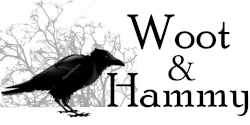

 What is the Symbolism & Meaning Behind the Wolf?
What is the Symbolism & Meaning Behind the Wolf? The Wolf as a Spirit Animal
The Wolf as a Spirit Animal Wolves in Chinese Culture
Wolves in Chinese Culture

21 Comments
cialis through canadian pharmacies https://canadacialisstore.com/ canadian pharmacy 5 mg daily cialis
best canada viagra pills online https://canadaviagrastore.com/ viagra canada by mail
buy tadalafil https://elitadalafill.com/ tadalafil
azithromycin zithromax over the counter https://zithromaxes.com/ generic name for z pack
purchase vardenafil online https://vegavardenafil.com/ us prices on vardenafil